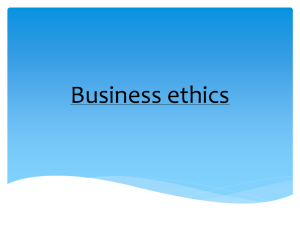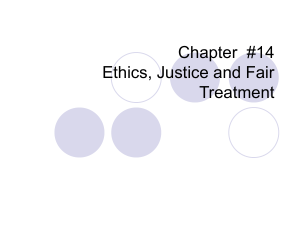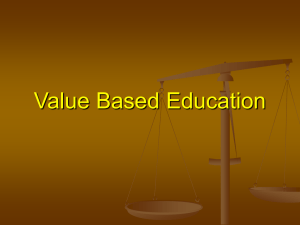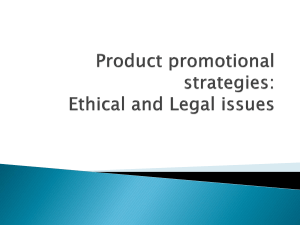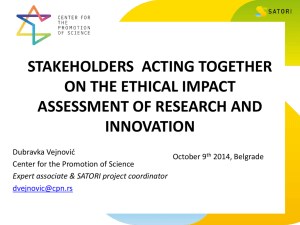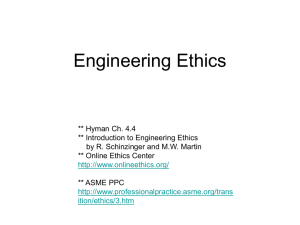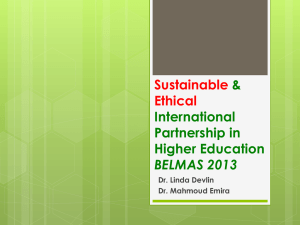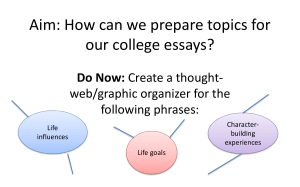Presentation
advertisement
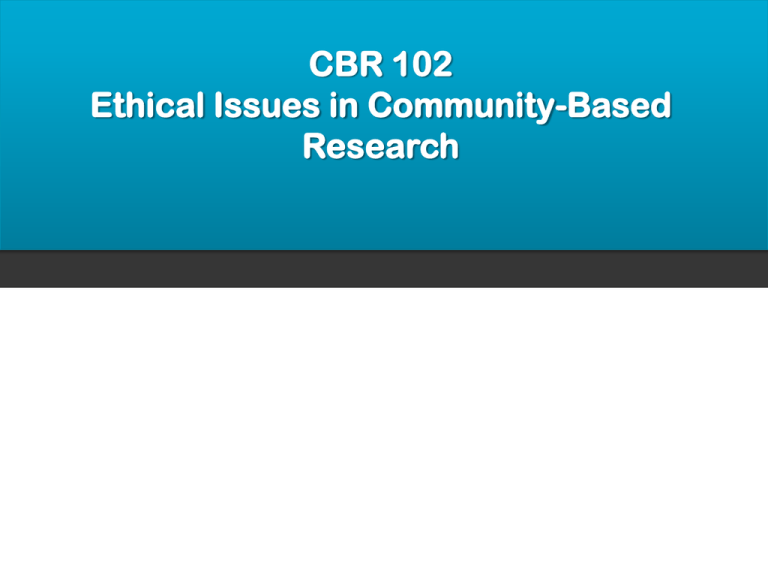
CBR 102 Ethical Issues in Community-Based Research INTRODUCTION Who works for a CBO? An academic institution? Is a student? Who has gone through an ethical review before? Who has written an ethics protocol? Who works with “vulnerable groups”? Who has obtained “consent” before? 2 LEARNING OBJECTIVES Upon completion of this workshop you will be able to: • Understand the importance of research ethics and “informed consent” • List the fundamental elements of ethical principles • Identify and prevent potential ethical issues in CBR • Problem solve different ethical issues commonly presented in CBR • Apply the Ethic Review Protocol Using Guiding Questions • Describe the ethics review process 3 WHAT WE WON’T DO TODAY … Magically solve major ethical dilemmas Give you quick and easy solutions 4 AGENDA • • • Define and establish need for ‘research ethics’; Ethics Principles Identify potential ethical issues in CBR & your project LUNCH • • • • Workshop Scenarios Ethics Review Process Ethics Review Protocol & Helpful Guiding Questions Workshop Evaluation 5 EXERCISE 1 – Defining Research Ethics 1. In your small groups, discuss what is meant by the term ‘research ethics’. 2. Then, create your own definition of research ethics to share with the large group. 6 TRI-COUNCIL DEFINITION... Morally acceptable ‘ends’ Morally acceptable means to those ‘ends’ Translation: You need a good reason to do research, and while you are doing it – you need to be ethical... So you can’t use the excuse that ‘the ends justify the means’ 7 HISTORIAL OVERVIEW Tuskegee Syphilis Study – 1932 Nazi eugenics, racial hygiene, and experimentation – 1934 8 PROTECTING ‘HUMAN SUBJECTS’ Nuremberg Code – 1949 World Medical Association, Declaration of Helsinki 1964 Tri-Council of Canada – 1970s 9 ETHICAL PRINCIPLES: Tri-Council 2005 1. 2. 3. 4. 5. 6. 7. 8. Respect for human dignity Respect for free and informed consent Respect for vulnerable persons Respect for privacy and confidentiality Respect for justice and inclusiveness Balancing harms and benefits Minimizing harms Maximizing benefits 10 EXERCISE 2: Protecting Human Rights Despite all of these ‘safeguards’ – we still see unethical research happen! In pairs, create a list of problems that can occur when unethical research takes place. 11 COMMON PROBLEMS IN RESEARCH • Communities feel coerced • Communities are lied to • Communities feel over researched • Insensitivity to community concerns or issues • Benefits to community are minimal • Irrelevance to community • Poor methodology (waste of resources) 12 EXERCISE 3: Identifying Potential Ethical Issues Research Project Goal: Identify support needs of non-status youth who have experienced domestic violence. 1. In small groups, describe what your assigned stage looks like in the project. 2. Next, identify some of the ethical issues that are likely to occur at this stage. 3. What safeguards could be put into place? 13 EXERCISE 4: Identifying Solutions to Ethical Issues Each group will be assigned an ethics scenario (found in your student handout). With your group, discuss the ethical issues involved with your scenario. Then, discuss how the ethical issues could be handled. Be prepared to share your ideas with the group. 14 ETHICAL REVIEW PROCESS 1. Ensures that you consider ethical issues upfront 2. Provides ample opportunity for your research team to flesh out issues 3. Forces you to put down on paper how you will handle potential mine-fields 4. Allows you to dialogue and problem solve before problems actually happen 5. Ensures that other ‘objective’ eyes will review your processes 15 PREPARING FOR AN ETHICAL REVIEW Ethical review is a requirement of almost all funders…so how does this work? You write a protocol & submit it to a Review Board ETHICAL REVIEW BOARDS Located in hospitals and universities. Composed of: Researchers Ethicists Community members Privacy officer 17 EXERCISE 5: EVALUATING AN ETHICS REVIEW PROTOCOL Review the sample ethics review protocol by yourself. When you have finished, in your same small groups, discuss the protocol section by section. Answer the guiding questions for each section. Be prepared to report back the extent to which the sample protocol answers the guiding questions. 18 EXERCISE 6: Learning into Practice 1. Working in pairs, create a project relevant to yourselves or your organizations (or feel free to use a project you are currently working on). 2. Work through an Ethics Review Protocol for this project. 3. Be prepared to discuss your results with the class! 19 TIPS FOR A SUCCESSFUL REVIEW 1. Start thinking about Ethics from day one. Identify ethical red flags throughout the design, and talk them through with your research partners. Do not leave your application until the last minute. 2. Assume the REB members know nothing. Unanswered questions will have to be addressed during a second round. Justify and explain your choices (append when needed). Be specific, even when you need to remain flexible. Recognise your expertise, acknowledge your limitations. Review REB protocol guidelines and ask for guidance when needed! 20 LEARNING OBJECTIVES Upon completion of this workshop you will be able to: • Understand the importance of research ethics and “informed consent” • List the fundamental elements of ethical principles • Identify and prevent potential ethical issues in CBR • Problem solve different ethical issues commonly presented in CBR • Apply the Ethic Review Protocol Using Guiding Questions • Describe the ethics review process 21 WORKSHOP EVALUATION Your feedback is important. Please complete the workshop evaluation. Thank you. 22 CBR 102 Ethical Issues in Community-Based Research

